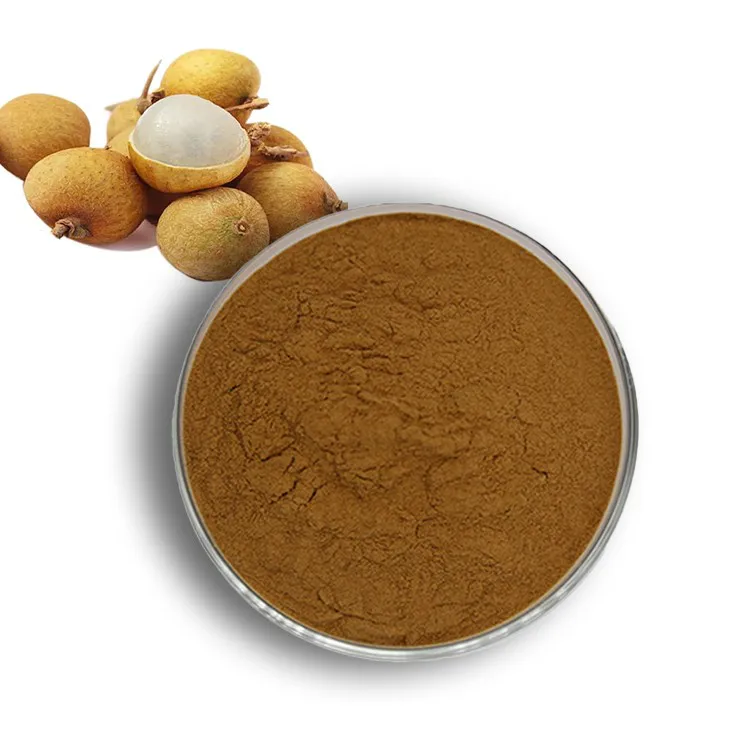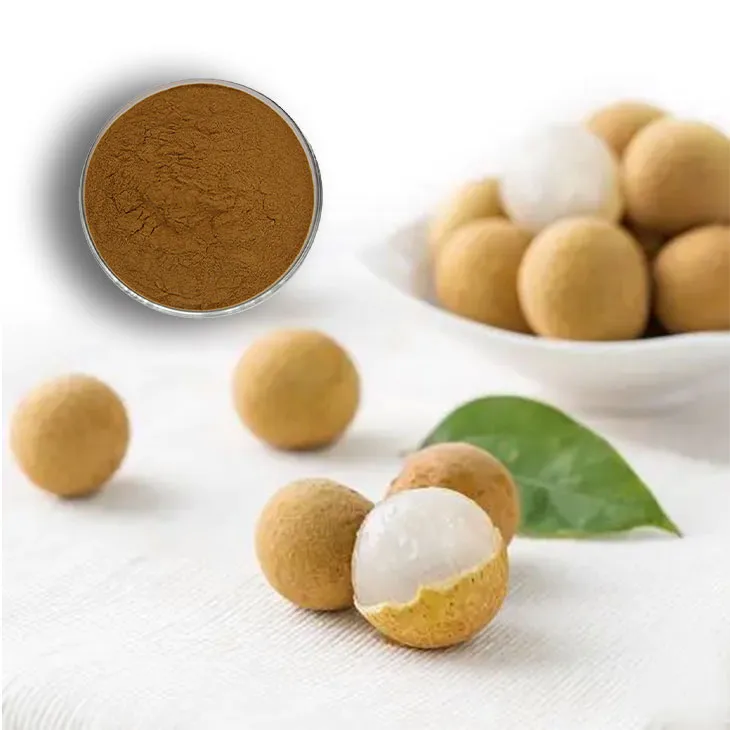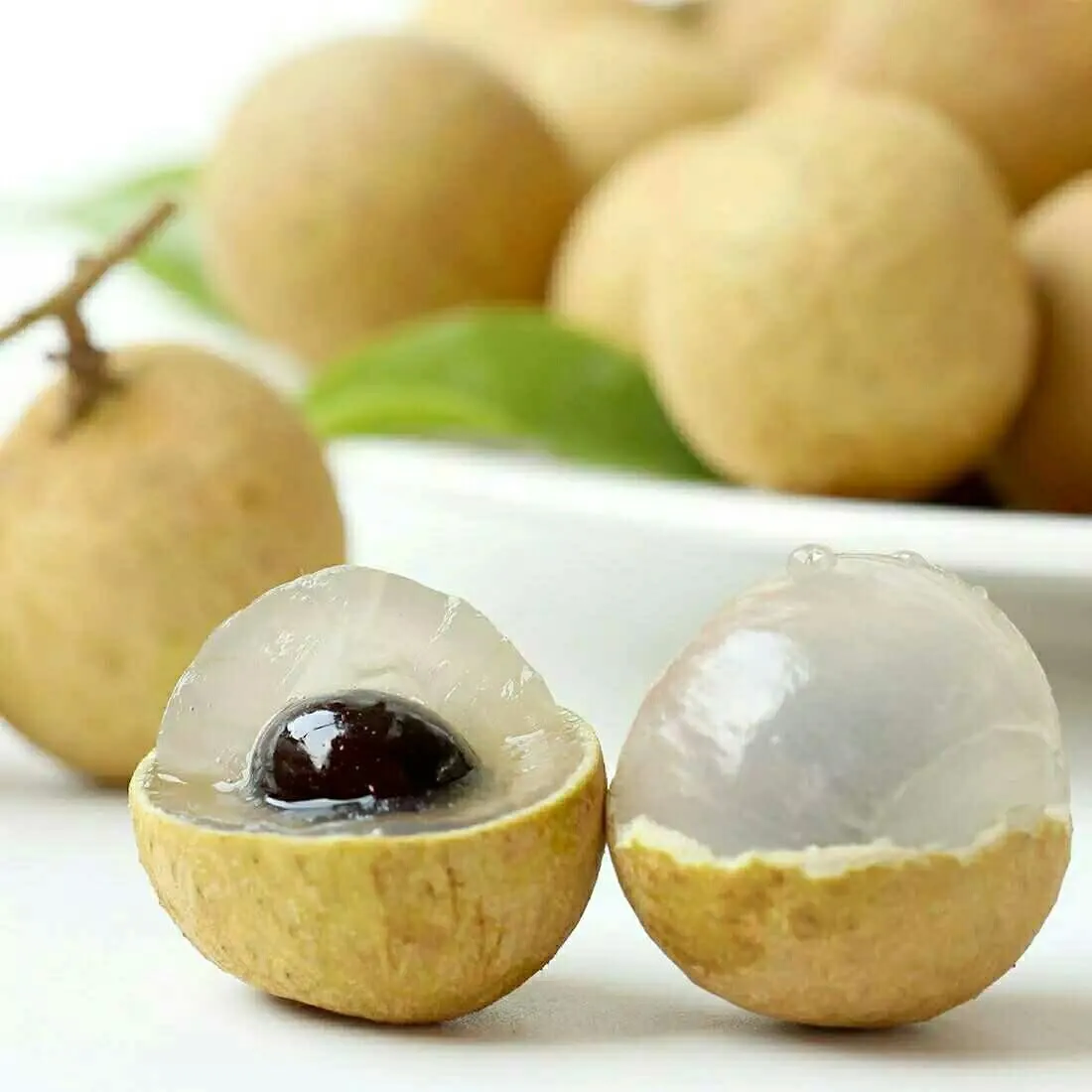- 0086-571-85302990
- sales@greenskybio.com
Extraction technology and production process of longan extract.
2024-11-29

1. Introduction
Longan, known as Dimocarpus longan Lour., is a popular fruit in many Asian countries. It is not only delicious but also rich in various nutrients and bioactive compounds. Longan Extract has a wide range of applications in the food, pharmaceutical, and cosmetic industries. Therefore, the extraction technology and production process of Longan Extract are of great significance.

2. Extraction Techniques
2.1 Solvent Extraction
Solvent extraction is one of the most common methods for extracting Longan Extract.
- The principle is based on the solubility of target compounds in a particular solvent. Different solvents can be used depending on the nature of the compounds to be extracted. For longan, polar solvents such as ethanol and methanol are often used. These solvents can dissolve many of the bioactive compounds present in longan, such as polysaccharides, flavonoids, and phenolic acids.
- The process typically involves grinding the longan fruits or dried longan into a powder. Then, the powder is mixed with the solvent in a certain ratio. For example, a common ratio could be 1:5 (longan powder: solvent) by weight. The mixture is then stirred continuously for a specific period, usually several hours. This allows the target compounds to dissolve into the solvent.
- After that, the mixture is filtered to separate the solid residue from the solvent containing the dissolved compounds. The filtrate is then concentrated, usually by evaporation, to obtain a more concentrated longan extract. However, solvent extraction has some limitations. One of the main problems is that it may leave behind some solvent residues in the final extract, which may affect the quality and safety of the product. Additionally, the extraction efficiency may not be as high as some other modern extraction techniques.
2.2 Supercritical Fluid Extraction
Supercritical fluid extraction (SFE) has emerged as an advanced extraction technique for longan extract.
- Supercritical fluids possess unique properties that make them excellent extraction media. Carbon dioxide (CO₂) is the most commonly used supercritical fluid in this process. When CO₂ is above its critical temperature (31.1°C) and critical pressure (7.38 MPa), it exhibits properties between those of a gas and a liquid. It has a high diffusivity like a gas, which allows it to penetrate into the longan matrix quickly, and at the same time, it has a certain solubility like a liquid, which can dissolve the target compounds effectively.
- The SFE process for longan extraction involves placing the longan material (either fresh or dried) into the extraction vessel. The supercritical CO₂ is then pumped into the vessel at the appropriate temperature and pressure conditions. The extraction time varies depending on the nature of the longan material and the desired extraction yield. After extraction, the supercritical CO₂ containing the dissolved longan compounds is depressurized, which causes the CO₂ to return to its gaseous state, leaving behind the concentrated longan extract.
- One of the major advantages of SFE is that it is a "green" extraction method. Since CO₂ is non - toxic, non - flammable, and easily removable from the final product, there are no solvent residue problems. Moreover, SFE can achieve a relatively high extraction efficiency and can selectively extract specific compounds from longan by adjusting the temperature, pressure, and other parameters. However, the equipment for SFE is relatively expensive, which limits its widespread application in small - scale production.
2.3 Microwave - Assisted Extraction
Microwave - assisted extraction (MAE) is another innovative extraction technique for longan extract.
- The principle of MAE is based on the interaction between microwaves and the longan matrix. Microwaves can cause rapid heating of the longan material due to the dielectric properties of the molecules present in it. This rapid heating generates internal pressure within the longan cells, which leads to the rupture of cell walls and the release of intracellular compounds. As a result, the target compounds are more easily extracted into the solvent.
- In the MAE process, the longan sample is mixed with a suitable solvent (similar to solvent extraction) and placed in a microwave - transparent vessel. The vessel is then placed in a microwave oven, and the extraction is carried out at a specific microwave power and for a certain time. For example, a microwave power of 300 - 600 watts and an extraction time of 5 - 15 minutes may be used depending on the quantity and nature of the longan sample. After extraction, the mixture is filtered and concentrated to obtain the longan extract.
- MAE has several advantages. It is a relatively fast extraction method compared to traditional solvent extraction. It can also reduce the amount of solvent used, which is beneficial for environmental protection and cost - saving. However, one potential drawback is that over - exposure to microwaves may cause degradation of some heat - sensitive compounds in longan. Therefore, careful control of the microwave parameters is crucial to ensure the quality of the extract.

3. Production Process
3.1 Raw Material Selection
The first step in the production process of longan extract is the selection of high - quality raw materials.
- When choosing longan fruits, factors such as variety, ripeness, and freshness need to be considered. Different longan varieties may have different chemical compositions and flavors. For example, some varieties may be richer in polysaccharides, while others may have a higher content of flavonoids. Ripe longan fruits are preferred as they generally contain higher levels of nutrients and bioactive compounds.
- In addition to fresh longan, dried longan can also be used as a raw material. Dried longan has a longer shelf - life and may have a more concentrated flavor. However, the quality of dried longan should also be carefully evaluated, including factors such as drying methods and storage conditions. Improper drying or storage may lead to the loss of some active ingredients or the presence of contaminants.
3.2 Pretreatment
Pretreatment of longan is an important step before extraction.
- The longan fruits are first washed thoroughly to remove dirt, dust, and any surface contaminants. This is especially important for fresh longan as it may have been exposed to various environmental factors during growth and harvesting.
- For fresh longan, the next step may be to remove the peel and seed. The peel can be removed manually or by using mechanical peeling devices. Removing the seed is also necessary as it may contain substances that are not desired in the extract or may interfere with the extraction process. However, in some cases, such as when extracting certain compounds from the whole longan including the seed, the seed may be retained.
- After peeling and seeding (if applicable), the longan flesh is usually cut into small pieces or ground into a paste. This increases the surface area of the longan material, which is beneficial for the subsequent extraction process as it allows for better contact between the longan and the extraction solvent or supercritical fluid.
3.3 Extraction
As mentioned earlier, different extraction techniques can be used for longan extraction.
- If solvent extraction is chosen, the pretreated longan material is mixed with the solvent according to the appropriate ratio and extraction conditions. The extraction is carried out with continuous stirring to ensure sufficient contact between the longan and the solvent.
- For supercritical fluid extraction, the longan material is placed in the extraction vessel, and the supercritical fluid (usually CO₂) is introduced at the correct temperature and pressure settings. The extraction process is monitored to ensure that the desired compounds are being extracted effectively.
- In the case of microwave - assisted extraction, the longan - solvent mixture is placed in the microwave - transparent container and subjected to microwave irradiation under the proper power and time conditions.
3.4 Purification
After extraction, the obtained longan extract may contain impurities and unwanted substances. Purification is necessary to obtain a high - quality product.
- One common purification method is filtration. Filtration can remove large particles, such as undissolved longan residues and some insoluble impurities. Different types of filters can be used, such as filter paper, membrane filters, or sintered filters, depending on the size of the particles to be removed.
- Another purification approach is chromatography. Column chromatography, for example, can be used to separate and purify specific compounds in the longan extract. By using different stationary and mobile phases, compounds can be selectively retained or eluted, allowing for the isolation of pure bioactive compounds from the extract. However, chromatography is a relatively complex and expensive method and is usually used for more high - value or research - oriented applications.
3.5 Concentration
The final step in the production process of longan extract is concentration.
- If solvent extraction is used, the filtrate obtained after purification usually contains a large amount of solvent. Concentration is carried out to reduce the solvent content and increase the concentration of the longan extract. Evaporation is a common method for concentration. It can be carried out under normal pressure or reduced pressure. Reduced - pressure evaporation is often preferred as it can lower the evaporation temperature, which is beneficial for protecting heat - sensitive compounds in the extract.
- For supercritical fluid extraction, the depressurization step itself can lead to a certain degree of concentration as the supercritical fluid (CO₂) is removed. However, further concentration may still be required depending on the final product requirements. In this case, similar evaporation methods can be used.
- After concentration, the longan extract is usually in a more concentrated form, which can be further processed into various products, such as dietary supplements, food additives, or cosmetic ingredients.

4. Factors Influencing Extraction Efficiency and Quality
4.1 Temperature
Temperature plays a crucial role in the extraction of longan extract.
- In solvent extraction, an appropriate increase in temperature can usually enhance the solubility of target compounds in the solvent. For example, when using ethanol as a solvent, increasing the temperature within a certain range can make polysaccharides and flavonoids in longan more soluble in ethanol. However, if the temperature is too high, it may cause the degradation of some heat - sensitive compounds, such as certain vitamins and phenolic acids present in longan.
- In supercritical fluid extraction, temperature affects the density and solubility of the supercritical fluid. For CO₂ - based SFE, an increase in temperature above the critical temperature can change the properties of CO₂, which in turn affects its ability to dissolve longan compounds. The optimal temperature needs to be determined based on the specific compounds to be extracted and the overall extraction process requirements.
- In microwave - assisted extraction, temperature is directly related to the microwave power and extraction time. Higher microwave power usually leads to a faster increase in temperature. If the temperature rises too quickly or exceeds a certain limit, it may also cause damage to the longan compounds. Therefore, precise control of temperature is essential for obtaining a high - quality longan extract in all extraction methods.
4.2 Pressure
Pressure is an important factor, especially in supercritical fluid extraction.
- In SFE using CO₂, pressure has a significant impact on the density and solubility of CO₂. Increasing the pressure can increase the density of CO₂, which in turn enhances its solubility for longan compounds. However, too high a pressure may also lead to some problems, such as equipment damage and increased energy consumption. Therefore, the optimal pressure needs to be carefully selected to balance extraction efficiency and cost - effectiveness.
- In solvent extraction and microwave - assisted extraction, although pressure does not play as direct a role as in SFE, changes in pressure can still affect the extraction process to some extent. For example, in solvent extraction, changes in atmospheric pressure may affect the evaporation rate during concentration, which in turn affects the final concentration of the longan extract.
4.3 Extraction Time
Extraction time is another factor that influences the extraction efficiency and quality of longan extract.
- In solvent extraction, a longer extraction time generally allows more target compounds to be dissolved into the solvent. However, after a certain point, the extraction rate may slow down significantly, and continuing the extraction for a long time may not be cost - effective. Moreover, a very long extraction time may also increase the risk of contamination and degradation of the extract.
- In supercritical fluid extraction, the extraction time needs to be optimized based on the nature of the longan material and the extraction conditions. Too short an extraction time may result in incomplete extraction of the desired compounds, while too long an extraction time may lead to unnecessary energy consumption and potential degradation of the compounds.
- In microwave - assisted extraction, the extraction time is closely related to the microwave power. A proper combination of microwave power and extraction time is required to ensure efficient extraction without causing damage to the longan compounds. Usually, a shorter extraction time can be achieved with higher microwave power, but this also requires more careful control to avoid over - heating.

5. Conclusion
The extraction technology and production process of longan extract are complex and multi - faceted. Different extraction techniques, including solvent extraction, supercritical fluid extraction, and microwave - assisted extraction, each have their own advantages and limitations. The production process involves several key steps such as raw material selection, pretreatment, extraction, purification, and concentration. Factors such as temperature, pressure, and extraction time significantly influence the extraction efficiency and quality of longan extract. With the continuous development of technology, it is expected that more efficient and environmentally friendly extraction methods will be developed for longan extract in the future, which will further expand its application in various industries.
FAQ:
What are the main extraction techniques for longan extract?
There are several main extraction techniques for longan extract. Solvent extraction is a common method, which uses an appropriate solvent to dissolve the active components in longan. Supercritical fluid extraction is also used, where supercritical fluids with special properties are employed to extract the desired substances. Additionally, microwave - assisted extraction utilizes microwave energy to enhance the extraction process.
How important is raw material selection in the production process of longan extract?
Raw material selection is extremely important in the production process of longan extract. High - quality longan fruits should be chosen as the raw materials. The maturity, freshness, and variety of longan can significantly affect the quality and yield of the extract. For example, fully ripe longan may contain more active ingredients, while fresh longan can ensure better extraction results.
What role does pretreatment play in the production of longan extract?
Pretreatment is a crucial step in the production of longan extract. It usually includes cleaning the longan fruits to remove dirt and impurities, and may also involve processes like drying or crushing. Cleaning helps to avoid contaminating the extract, and drying or crushing can increase the surface area of the longan, facilitating better extraction in the subsequent extraction step.
How do temperature, pressure, and extraction time influence the extraction efficiency and quality of longan extract?
Temperature, pressure, and extraction time are important factors influencing the extraction efficiency and quality of longan extract. Higher temperature can often increase the solubility of the active components in longan, but if it is too high, it may cause the degradation of some heat - sensitive components. Appropriate pressure in supercritical fluid extraction can affect the density and solubility of the extraction fluid, thus influencing the extraction effect. The extraction time also needs to be optimized. If it is too short, the extraction may be incomplete, and if it is too long, it may introduce unwanted substances or cause degradation.
What are the common purification methods in the production process of longan extract?
Common purification methods in the production process of longan extract include filtration, chromatography, and crystallization. Filtration can remove large - particle impurities. Chromatography can separate different components based on their different affinities to the stationary and mobile phases. Crystallization can be used to purify and isolate specific components by exploiting their solubility characteristics.
Related literature
- Advances in Extraction Technologies for Longan - Derived Compounds"
- "Optimization of Longan Extract Production: A Review"
- "The Influence of Extraction Parameters on Longan Extract Quality"
- ▶ Hesperidin
- ▶ citrus bioflavonoids
- ▶ plant extract
- ▶ lycopene
- ▶ Diosmin
- ▶ Grape seed extract
- ▶ Sea buckthorn Juice Powder
- ▶ Beetroot powder
- ▶ Hops Extract
- ▶ Artichoke Extract
- ▶ Reishi mushroom extract
- ▶ Astaxanthin
- ▶ Green Tea Extract
- ▶ Curcumin Extract
- ▶ Horse Chestnut Extract
- ▶ Other Problems
- ▶ Boswellia Serrata Extract
- ▶ Resveratrol Extract
- ▶ Marigold Extract
- ▶ Grape Leaf Extract
- ▶ blog3
- ▶ blog4
-
Organic konjac powder, Australia.
2024-11-29
-
Chinese Cassia Seed Extract Suppliers.
2024-11-29
-
Suppliers of Organic Diosmin Powder.
2024-11-29
-
Hesperidin with the best reviews.
2024-11-29
-
Organic Epimedium Extract Powder Supplier.
2024-11-29
-
Dandelion Leaf Extract
2024-11-29
-
Apricot Powder
2024-11-29
-
Hops Extract
2024-11-29
-
Nettle leaf extract
2024-11-29
-
Cocoa Extract
2024-11-29
-
Citrus bioflavonoids
2024-11-29
-
Selenium yeast
2024-11-29
-
Shikonin
2024-11-29
-
Ginger Extract
2024-11-29
-
Giant Knotweed Extract
2024-11-29





















